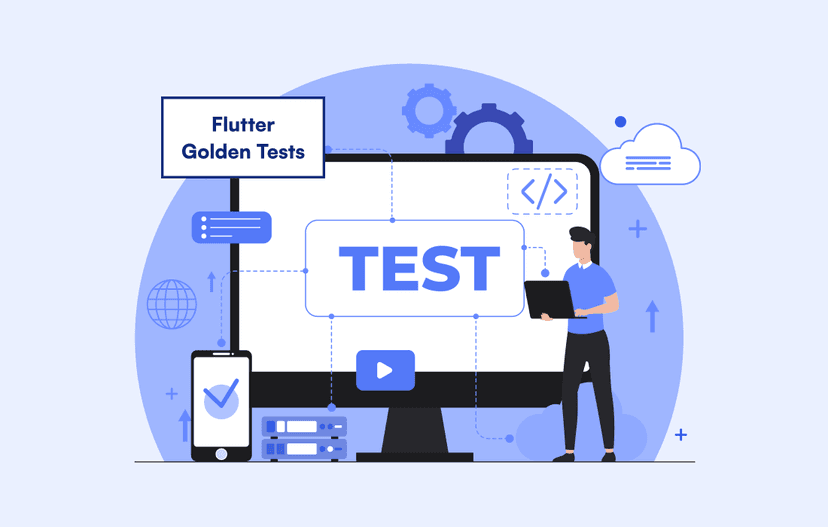Flutter vs Kotlin for Mobile App Development: 2025 Comparison
Choosing between Flutter and Kotlin can be tricky. This blog breaks down both frameworks based on performance, development speed, UI, cost, and best use cases. Get practical, experience-driven insights to decide which option fits your app, team, and project priorities in 2025.

See, if you’re planning to build a mobile app, you will have to choose between Flutter and Kotlin.
And the thing is, tech giants back both. Like Flutter by Google and Kotlin by JetBrains + Google. And both promise faster, scalable app development.
But they solve problems in very different ways.
- Flutter is a cross-platform framework that lets you build iOS and Android apps with a single codebase.
- Kotlin is a modern language that powers most Android apps today. It can also go cross-platform with Kotlin Multiplatform.
In this blog, I will share my thoughts on Flutter vs Kotlin.
But why should you trust my words?
Well, I have helped many businesses and startups with Flutter and Kotlin development. So I know when they need what.
So get yourself a coffee, and let’s start this.
Table of Contents
What is Flutter, & When is it used?
Flutter is Google’s cross-platform framework. The main reason businesses pick Flutter app development is simple: one codebase for iOS and Android.
That alone saves time, cost, and headaches of maintaining two teams.
From my experience, Flutter is best when speed and design matter. Startups often choose it to ship an MVP quickly, test their idea on both stores, and still get an app that looks polished. The widget system also makes UI customization a lot easier compared to native.
When do I usually recommend Flutter?

- When the goal is to serve both iOS + Android users together.
- When your budget is limited but expectations are high.
- When you have time constraints and want to get things done fast.
Also, if you are having some thoughts about Flutter, then do check our comparison of Flutter and React Native.
What is Kotlin, & When is it used?
Kotlin is a multiplatform programming language backed by JetBrains. And it is highly preferred for Android development.
If you open the Play Store, a lot of the apps you see are either built in Kotlin or migrated to it from Java.
It makes them stable and helps them integrate directly with the Android ecosystem.
But Kotlin isn’t limited to Android anymore.
Why? Because with Kotlin Multiplatform, you can share business logic across Android and iOS. All this can be done while you’re building separate UIs.
I’ve seen this approach work well for companies that need performance-heavy apps.
When do I usually recommend Kotlin?

- When Android is the primary market.
- When you need high performance and deeper control of the app.
- When the project already has an Android base and is expanding further.
In-Depth Comparison of Flutter and Kotlin

Here’s how Flutter and Kotlin stack up against each other on the factors that actually matter in app development:
1. Performance
Flutter is fast for most apps. Animations and UI run smoothly. In my experience, it handles typical business apps well. For apps that are heavy on background tasks or need deep device integrations, Kotlin performs better because it’s fully native.
2. Development Speed
See, Flutter lets you build iOS + Android apps from a single codebase. This makes it ideal when speed matters. Kotlin is great for Android-only apps, but if you need iOS too, development takes longer since UIs have to be built separately.
3. UI/UX Capabilities
Flutter’s widget system makes it easy to create consistent, polished interfaces. It’s fast to prototype and adjust designs. Kotlin gives full control over native UI. It’s best when platform-specific design and performance are top priorities, but custom UI takes more effort.
4. Learning Curve
Flutter uses Dart, which is easy to learn, for sure. But it still adds a time delay if your team is new. And Kotlin is simpler for developers with Java experience. Why? Because it integrates smoothly with existing Android projects.
If you want to avoid the learning curve, then you can hire Kotlin Developers and experienced Flutter Developers.
5. Community & Ecosystem
Flutter has a rapidly growing community backed by Google. Most common needs are covered by plugins, though niche cases can require extra work. Kotlin’s ecosystem is mature. It has strong support from JetBrains and Google, with plenty of libraries and resources.
5. Integration & Plugins
Flutter works well for standard integrations. For advanced hardware features, some native code is needed. Kotlin has direct access to all Android APIs, which makes integrations easier, especially for device-specific or performance-heavy features.
6. Cost of Development
Flutter can save time and money for cross-platform apps because you maintain a single codebase. Kotlin can be more expensive for apps targeting both platforms, since UI has to be built separately for iOS and Android.
For more details, check out our blog on Flutter app development cost
Flutter vs Kotlin Comparison Table
A table summarizing the different aspects of Flutter vs Kotlin
| Feature | Flutter | Kotlin |
| Programming Language | Dart | Kotlin |
| Backed By | Google & Community | JetBrains |
| Launched in | 2017 | 2011, 2020 (Multiplatform) |
| Architecture | Everything is a Widget | Share Business logic, Native UI |
| UI Approach | Custom rendering engine | Platform-native UI |
| Code Sharing | Upto 90% | 50-90% business logic |
| Learning Curve | Moderate | Steep |
| Compilation | Native ARM | Platform-specific |
| Hot Reload | Yes | Limited |
| Testing Tools | Built-in testing | Kotlin test framework |
| IDE Support | Android Studio | IntelliJ IDEA |
| App Size | Large | Smaller as compared to Flutter |
| Community Size | Large and Active | Growing |
| Popular Apps | Gpay, BMW, Toyota, Google Ads | Pinterest, Trello, Slack, Evernote |
Which One Should You Pick? Flutter or Kotlin?
The choice isn’t about which is “better” overall; it’s about what fits your app.
See, I usually go by this rule:
- I recommend Flutter when I need to launch on both iOS and Android quickly. It’s faster to build and easier to maintain. As simple as that. This is best for startups or someone who wants to build a quick MVP.
- Now, Kotlin is my choice when the app needs to be Android-first. Or when the app needs high performance. In such cases, you need something that handles device-specific features and complex integrations smoothly. For that, you need native Android capabilities, and hence Kotlin is safer.
In practice, I’ve seen teams choose Flutter for cross-platform speed, then later add Kotlin modules for performance-heavy features. It’s not always one or the other. Sometimes a mix works best.
FAQs
1. Is Flutter better than Kotlin?
Flutter is faster if you want to build for both iOS and Android at the same time. But Kotlin is better if your app is Android-first or needs heavy native features. I usually choose based on the project’s priorities.
2. Can Kotlin replace Flutter?
Not really. Kotlin can share logic across platforms, but you’ll still need separate UIs. Flutter handles iOS and Android with one codebase, which is its main advantage.
3. Which runs faster, Flutter or Kotlin?
Flutter runs well for most apps, but Kotlin is fully native on Android. For CPU-heavy tasks or complex device integrations, Kotlin performs better.
4. Which should a startup pick?
I often recommend Flutter. You can launch faster, maintain one codebase, and still get a polished app. Kotlin works better if the startup is Android-first and performance matters more than speed.
5. Which is more cost-effective, Flutter or Kotlin?
Flutter is usually cheaper since you maintain one codebase for both iOS and Android. But Kotlin often requires separate work for each platform, which increases the budget.
6. Can I add Kotlin to a Flutter app later?
Yes. You can integrate Kotlin modules for features that need native performance. But a full switch from Flutter to Kotlin means rewriting platform-specific parts.
Need a Tech Partner Who Knows Both Flutter & Kotlin?
From MVPs to complex apps, we’ve delivered with both stacks.

Strict NDA

Trusted by Startups & Enterprises Worldwide

Flexible Engagement Models

1 Week Risk-Free Trial
Give us a call now!

+1 (724) 577-7737


